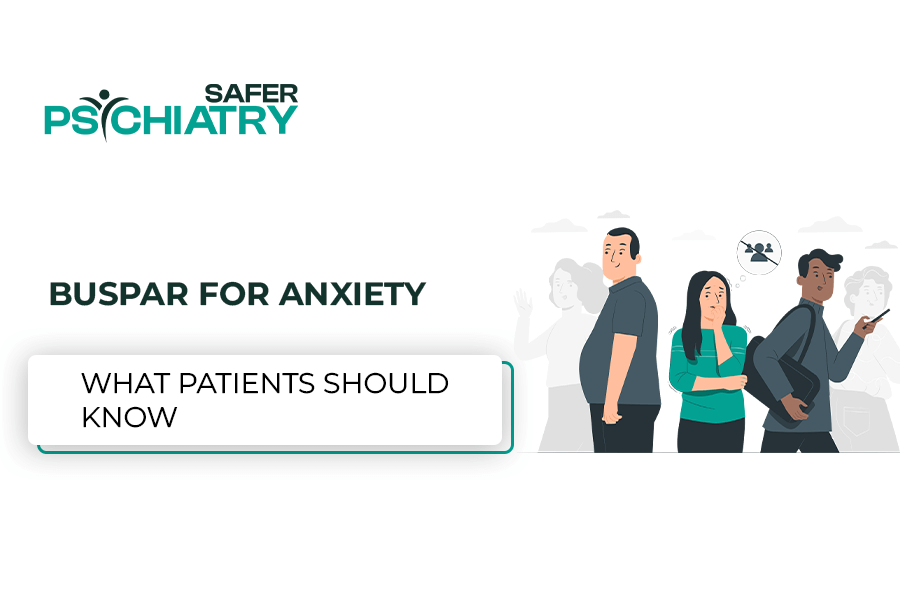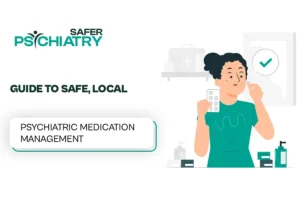
Buspar for Anxiety - What Patients
Should Know
At Safer Psychiatry, we provide compassionate, evidence – based mental health care to support your well-being now and for the future – because your journey matters, and so do you.

- Buspar (buspirone) is a non-sedating, non-addictive medication used for generalized anxiety disorder (GAD).
- How it works: Balances serotonin and dopamine levels to reduce constant worrying, restlessness, and tension.
- Who it’s for: Adults with GAD seeking alternatives to benzodiazepines or who have not tolerated SSRIs well.
- Timeframe: Buspar does not work immediately; it takes 1–2 weeks for initial effects and 4–6 weeks for full benefits.
- Dosage: Starting dose is 7.5 mg twice daily, with a max dose of 60 mg/day, taken consistently (not PRN/as needed).
- Side effects: Many cause dizziness, nausea, headache, or insomnia. Generally mild and lessen over time.
- Safety: Considered safe long-term, without the sedation or dependency risks linked to Xanax, Ativan, or other benzos.
- Limitations: Not fast-acting; not typically used for panic attacks or acute anxiety relief.
What Is Buspar for Anxiety?
Buspar (buspirone) is a non-sedating, non-addictive medication used for the treatment of generalized anxiety disorder (GAD). Unlike fast-acting drugs such as Xanax or Ativan, Buspar for anxiety works gradually to reduce constant worry, restlessness, and tension.
Does Buspar work immediately?
The answer is no Buspar is not a fast-acting medication. It usually takes 1–2 weeks to begin showing benefits, and 4–6 weeks for full effectiveness.
How Does Buspar Work in the Brain?
Buspar works by balancing serotonin and dopamine—two important brain chemicals that affect mood, thought patterns, and anxiety.
Unlike benzodiazepines, it is not a sedative and does not cause dependence, making it a safer long-term anxiety medication.
Key effects of Buspar include:
- Reduced constant worrying
- Less restlessness
- Improved concentration
- Lower feelings of being “on edge”
Who Should Consider Buspar?
Buspar for anxiety is best suited for individuals who:
- Have generalized anxiety disorder
- Prefer a non-habit-forming treatment
- Are start anxiety treatment for the first time
- May have had poor experiences with SSRIs or benzodiazepines
It is not typically recommended for panic disorder or rapid relief of acute anxiety episodes.
Patients with liver or kidney disease, or those who are pregnant or breastfeeding, should discuss risks with their psychiatrist before starting Buspar.
Buspar Dosage and How to Take It
The starting dose of Buspar for anxiety is usually 7.5 mg twice daily. Depending on your response, the dosage may be increased gradually.
- Buspar dosage for anxiety (typical range): 20–30 mg/day
- Max dose of Buspar for anxiety: 60 mg/day
- Buspar dosage for panic attacks: Sometimes prescribed off-label but less common
- Buspar PRN for anxiety (as needed use): Not recommended, Buspar must be taken consistently, not only when symptoms appear.
Tip: Take Buspar at the same time daily, with or without food, to maintain stable levels in your body.
How Long Does Buspar Take to Work?
Buspar usually takes 1–2 weeks to show its calming effects, and full results may take up to 4–6 weeks. This slower onset is normal and expected.
Patients at Safer Psychiatry often report gradual improvement in sleep, worry levels, and ability to manage daily stress over the first month of use.
Common Side Effects of Buspar
Most people tolerate Buspar well. However, you may notice:
- Dizziness or drowsiness
- Nausea or dry mouth
- Headache
- Trouble sleeping
- Nervousness
These symptoms usually lessen as your body adjusts. Contact your care team if they persist or worsen.
Seek immediate help if you experience:
- Rash, swelling, or difficulty breathing
- Irregular heartbeat
- Muscle stiffness, fever, or confusion (possible serotonin syndrome)
Buspar vs. Other Anxiety Medications
Medication | Sedating | Risk of Dependence | Fast-Acting | Long-Term Use |
Buspar | No | No | No | Yes |
Yes | Yes | Yes | No | |
Lexapro | No | No | No | Yes |
Hydroxyzine | Yes | No | Yes | Occasionally |
Gabapentin | Mild | Low-moderate | No | Yes (off-label) |
Real insight: “In our clinic, Buspar is often used for patients who’ve struggled with SSRIs or want to avoid dependency risks associated with benzos. It’s a gentle but reliable long-term option.”
Buspar for Different Conditions
- Buspirone for anxiety (GAD): Most common use, especially for chronic worry.
- Buspar for panic attacks: Sometimes prescribed but not the first choice.
- Buspar for depression: Occasionally used as an add-on treatment with antidepressants.
- Buspar for GAD: Strong evidence supports effectiveness in generalized anxiety disorder.
Key Benefits of Buspar for Anxiety
- Non-addictive and safe for long-term use
- No sedation or “foggy” feeling
- Effective for generalized anxiety disorder
- Can be a good alternative for patients who don’t tolerate SSRIs or benzodiazepines
Is Buspar Safe Long-Term?
Yes. Buspar is considered safe for extended use, especially for those seeking a gentle option without dependency. Patients who stick with it often experience steady, sustained relief with fewer interruptions to daily life.
Still, regular check-ins with your psychiatrist are essential for monitoring effectiveness and adjusting the dose if needed.
Final Thoughts
Buspar is a safe, effective, and long-term treatment option for adults with generalized anxiety disorder who want relief without sedation or dependency risks. If you’re struggling with ongoing anxiety, talk to your psychiatrist about whether Buspar for anxiety is the right option for you.
Buspar for anxiety offers thoughtful alternative to traditional anti-anxiety medications, one that supports stability without sedation or addictive risks.
If you or a loved one are struggling with ongoing anxiety and want to explore medication options, we’re here to help.
Disclaimer: This article is for informational purposes only and does not establish medical advice. Always consult your psychiatrist or healthcare provider before starting or changing any medication.
FAQ
Frequently Asked Questions
What is Buspar used for?
Buspar is prescribed for generalized anxiety disorder (GAD). It helps reduce chronic worry, tension, and irritability without sedation or dependency risks.
How quickly can I expect Buspar to relieve my anxiety symptoms?
Buspar is not a quick fix, it works gradually. Most patients start noticing some improvement after about 1 to 2 weeks, but it can take up to 4 to 6 weeks to experience its full benefits. Consistency is important, so take it as prescribed even if you don’t feel better right away.
Can I take Buspar only when I have an anxiety attack?
Buspar is intended to be taken regularly, not just during anxiety attacks. Taking it daily helps maintain balanced brain chemistry to prevent anxiety symptoms, rather than stopping an attack after it starts.
Does Buspar work immediately for anxiety?
No. Unlike benzodiazepines, Buspar is not fast-acting. It usually takes 1–2 weeks to notice improvement and up to 6 weeks for full results.
Is Buspar safe for old patients with anxiety?
Buspar can be prescribed to older adults, but because they may be more sensitive to side effects like dizziness or low blood pressure, doctors usually start with a lower dose and monitor carefully.
Can you take Buspar as needed (PRN) for anxiety?
No. Buspar must be taken consistently every day to be effective. It is not intended for PRN use or acute anxiety episodes.
What is the starting dose of Buspar for anxiety?
The typical starting dose is 7.5 mg twice daily, with gradual increases if needed. The maximum dose is 60 mg per day.
Is Buspar sedating?
No. Buspar is non-sedating and does not impair alertness, making it safer for daytime use compared to Xanax or hydroxyzine.
Our Company
Copyright © 2024 Safer Psychiatric Consulting Services


